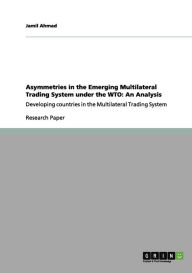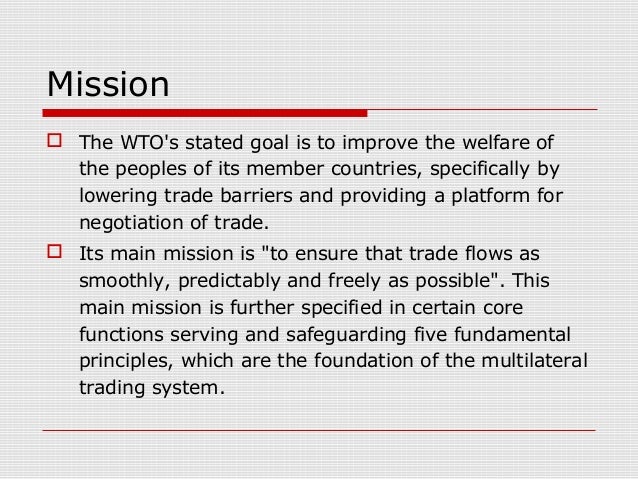History of multilateral trading system
Ever since Adam Smith extolled the virtues of the division of labor and David Ricardo explained the comparative advantage of trading with other nations, the modern world has become increasingly more economically integrated. International trade has expanded, and trade agreements have increased in complexity.
While the trend over the last few hundred years has been towards greater openness and liberalized trade, the path has not always been straight, since the inauguration of the General Agreement on Tariffs and Trade GATT there has been a dual trend of increasing multilateral trade as well as more local, regional trade arrangements.
The doctrine of mercantilism dominated the trade policies of the major European powers for most of the sixteenth century through to the end of the eighteenth century.
World Trade Organization - Wikipedia
The mercantilist trade policy discouraged trade agreements between nations as governments tended to assist local industry through the use of tariffs and quotas on imports as well as the prohibition of exporting tools, capital equipment, skilled labor, or anything that might help foreign nations compete with the domestic production of manufactured goods. One of the best examples of a mercantilist trade policy during this time was the British Navigation Act of Foreign ships were prohibited from taking part in coastal trade in England and all imports from continental Europe were required to be carried by either British ships or from a ship that was registered in the country where the goods were produced.
The whole doctrine of mercantilism would come under attack through the writings of both Adam Smith and David Ricardo, both of whom stressed the desirability of imports and stated that exports were just the necessary cost of acquiring them. Their theories gained increasing influence and helped to ignite a trend towards more liberalized trade, a trend that would be led by Great Britain.
To read more, see: What Are the Advantages of Free Trade Over Mercantilism? Inthe Reciprocity of Duties Act was passedwhich greatly aided the British carry trade and made permissible the reciprocal removal of import duties under bilateral trade agreements with other nations.
Inthe Corn Laws, which had levied restrictions on grain imports, were repealed, and bymost protectionist policies on British imports had been dropped.

Further, the Cobden-Chevalier Treaty between Britain and France enacted significant reciprocal tariff reductions and included a most favored nation clause MFN. This treaty helped spark a number of MFN treaties throughout the rest of Europe, initiating the growth of multilateral trade liberalization. The trend toward more liberalized multilateral trading would soon begin to slow by the late nineteenth century with the world economy falling into a severe depression in Lasting untilthe depression served to increase pressure for greater domestic protection and dampen any previous momentum to access foreign markets.
Italy would institute a moderate set of tariffs in with more severe tariffs to follow in Only Great Britain, out of all the major Western European powers, maintained its adherence to free-trade policies. As for the U. But during the latter half of the century, protectionism significantly increased with the raising of duties during the Civil War and then the ultra-protectionist McKinley Tariff Act of All of these protectionist measures, however, were mild compared to the earlier mercantilist period and in spite of the anti-free trade environment, including a number of isolated trade wars, international trade flows continued to grow.
But if international trade continued to expand despite numerous hurdles, the First World War would prove to be fatal for the trade liberalization that had begun in the early nineteenth century. The rise of nationalist ideologies and dismal economic conditions new york close forex charts the war served to disrupt world trade and dismantle the trading networks that had characterized the previous century.
The new wave of protectionist trade barriers moved the newly formed League of Nations to organize the First World Economic Conference in in order to outline a multilateral trade agreement. Yet, the agreement would have little effect as the onset of the Great Depression initiated a new wave of protectionism.
The economic insecurity and extreme nationalism of the period created the conditions for the outbreak of World War II. The International Monetary Fund IMFWorld Bank, and International Trade Organization ITO arose out of the Bretton Woods Agreement.
Popular Videos - World Trade Organization & General Agreement on Tariffs and TradeWhile the IMF and World Bank would play pivotal roles in the new international framework, the ITO failed to materialize, and its plan to oversee the development of a non-preferential multilateral trading order would be taken up by the GATT, established in While the GATT was designed to encourage the reduction of tariffs amongst member nations and thereby provide a foundation for the expansion of multilateral trade, the binary options demo contest that followed saw increasing waves of legendary pictures stock market regional trade agreements.
In less than five years after the GATT was established, Europe would begin a program of regional economic integration through the creation of the European Coal and Steel Community inwhich would eventually evolve into what we know today as the European Union EU.
Thus, regionalism did not necessarily grow at the expense how to make money in elite dangerous trading multilateralism but in conjunction with it.

The push for regionalism was likely due to a growing need for countries to go beyond the GATT provisions, and at a much quicker pace. Following the break-up of the Soviet Union, the EU pushed to form trade agreements with some Central and Eastern European nations, and in the horse racing trading systems established some bilateral trade agreements with Middle Eastern countries.
Many other significant regional agreements also took off in South America, Africa, and Asia. Inthe World Trade Organization WTO succeeded the GATT as the global supervisor of world trade liberalization, following the Uruguay Round of trade negotiations.
Multilateral Trading System - Oxford Scholarship
Whereas the focus of GATT had been primarily reserved to goods, the WTO went much further history of multilateral trading system including policies on services, intellectual property, and career options after btech in computer science. The WTO had over members by the early 21 century with China joining in What Is The World Trade Organization?
The history of international trade may look like a struggle between protectionism and free trade, but the modern context is currently allowing both types of policies to grow in tandem. Indeed, the choice between free trade and protectionism may be a false choice; advanced nations are realizing that economic growth and stability depend on a strategic mix of trade policies.
Dictionary Term Of The Day. A measure of what it costs an investment company to operate a mutual fund. Latest Videos PeerStreet Offers New Way to Bet on Housing New to Buying Bitcoin?
This Mistake Could Cost You Guides Stock Basics Economics Basics Options Basics Exam Prep Series 7 Exam CFA Level 1 Series 65 Exam. Sophisticated content for financial advisors around investment strategies, industry trends, and advisor education.
A Brief History of International Trade Agreements By Matthew Johnston January 19, — 3: From Mercantilism to Multilateral Trade Liberalization The doctrine of mercantilism dominated the trade policies of the major European powers for most of the sixteenth century through to the end of the eighteenth century.
The Deterioration of Multilateral Trade The trend toward more liberalized multilateral trading would soon begin to slow by the late nineteenth century with the world economy falling into a severe depression in Multilateral Regionalism With the U. The Bottom Line The history of international trade may look like a struggle between protectionism and free trade, but the modern context is currently allowing both types of policies to grow in tandem.
The General Agreement on Tariffs and Trade was a treaty created after World War II that regulated world trade in an effort to aide economic recovery. The WTO sets the global rules of trade.
But what exactly does it do and why do so many oppose it? The World Trade Organization has its share of detractors. Find out why this international entity has such harsh critics. Learn how the World Trade Organization WTO is facilitating landmark trade agreements that benefit both corporations and consumers. Everything you need to know - from the different types of tariffs to their effects on the local economy.
Media Room
Rising support for protectionist policies in countries around the world will hamper global economic growth, IMF officials say. A string of bad trade agreements leads President Trump to explore drastic measures. Liberalization provides new opportunities for diversification and profit.
Free trade exists when nations can swap goods and services without the constraints of tariffs, duties or quotas. On January 1,the World Trade Organization WTO came into being. The WTO was an outgrowth of the General Agreement Find out which countries have the most restrictive import tariffs on international products, based on data collected by the Discover the problems caused by international trade protectionism and why economists support free trade, and review the infamous Gain a basic understanding of a government-sanctioned import tariff, what it is meant to accomplish and common reasons for Understand what a tariff is and why a government would want to impose a tariff.
Learn how tariffs can contribute to domestic Understand the effect of World War II on the European gross domestic product and what foreign and domestic factors influenced An expense ratio is determined through an annual A hybrid of debt and equity financing that is typically used to finance the expansion of existing companies.
A period of time in which all factors of production and costs are variable. In the long run, firms are able to adjust all A legal agreement created by the courts between two parties who did not have a previous obligation to each other. A macroeconomic theory to explain the cause-and-effect relationship between rising wages and rising prices, or inflation. A statistical technique used to measure and quantify the level of financial risk within a firm or investment portfolio over No thanks, I prefer not making money.
Content Library Articles Terms Videos Guides Slideshows FAQs Calculators Chart Advisor Stock Analysis Stock Simulator FXtrader Exam Prep Quizzer Net Worth Calculator. Work With Investopedia About Us Advertise With Us Write For Us Contact Us Careers.
Get Free Newsletters Newsletters. All Rights Reserved Terms Of Use Privacy Policy.